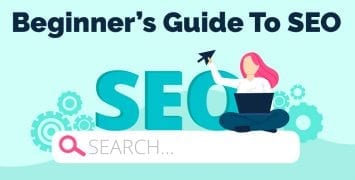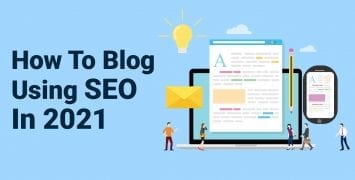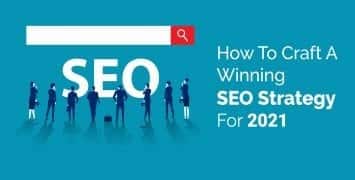Do You Own a Business?
This could be basically any type of business. You might have a store, or even a chain of stores, or you might run your business entirely from your home.
When it comes to the products you sell or the services you provide, you’re the expert. After all, you didn’t build your business overnight. You had to develop your expertise over time.
You know how to run your business, but do you know how to run your business online?
Every business needs an online presence. The question is this: Can you create and maintain a website yourself? Will a website made by someone who isn’t a web pro actually benefit and make money for a business?
This guide provides a complete overview on creating and maintaining an e-commerce site. You’ll learn what’s involved in making a website, why you should probably hire an internet marketing pro, what specifically that person can do for you, and everything else you’ll need to know about how SEO can help your business grow.
Should You Hire an Internet Marketing Professional?
This an interesting question. In one way, creating a website has never been easier than it is today. Even someone with limited computer skills can use WordPress or a similar program to get a basic site online pretty easily.
But usually a basic website isn’t enough. Your success online requires more than a simple site. In fact, your website is really only just the starting point. In order to attract potential customers and build overall brand awareness, you need to optimize your presence online in a variety of ways.
Building a basic website is something just about anyone can do. Optimizing that website, however, is a much different situation. Internet marketing strategies take years to properly learn, and implementing them effectively on a case-by-case basis a full-time job, at least when the site is initially created.
You’re an expert in the products or services you provide. When promoting your site online, you want someone similarly skilled and dedicated to their craft. That’s why basically all business owners will benefit from hiring an internet marketing pro. The end result will be a professional, engaging web presence that will help your brand grow and reach new potential customers.
You’ll get the best results – by far – from hiring an SEO professional.
What is Search Engine Optimization?
A website isn’t the main part of your online presence. Instead, your website needs to be optimized to draw traffic, attract potential customers, and generally increase your brand’s presence and effectiveness across the web.
This called SEO, which stands for Search Engine Optimization. There are many SEO strategies out there. Each one has a different purpose for a specific situation but the overall goal is always the same: To increase traffic and conversions for a website.
In other words, SEO identifies people who are interested in what you’re selling, directs them to your website, and encourages them to buy from you.
Generally speaking, optimizing a website for SEO involves:
- Creating a variety of specific content designed to attract and ultimately lead a potential customer to a sale
- Managing social media accounts to increase sales and overall brand awareness
- Identifying your customer base and then learning how to effectively communicate with them
- Running the site smoothly with the capability to quickly respond and fix any technical problems
- And more
Getting a site up and running from scratch really isn’t something you can just learn about as you go. Hiring a professional is very much recommended.
To be honest, if you have a real willingness to learn and an interest in this sort of stuff, you can do a fair amount of website maintenance yourself. Links to relevant resources are included throughout this guide. But even do-it-yourselfers will want a professional to build out the site initially.
So, SEO has a lot of moving parts. Let’s start by taking a look at the big picture stuff:
How Does SEO Relate to Search Engines?
SEO strategies will generally impact a site’s results on the three major search engines. These are Google, Bing, and Yahoo. You’ll also see an impact across lesser-known search engines, but those top three are where you’ll find the most impact on traffic.
When your site is properly optimized, that means it has a lot of characteristics search engines consider valuable. The underlying algorithm for every search engine is complicated (to put it mildly) but the basic idea is pretty straightforward:
Search engines reward sites that easily provide people with the information they’re searching for.
The more you can present clear, engaging, and original answers to common questions, the more search engines will favor you.
There’s a loop of good things that can occur. The better your SEO, the higher you’ll rank in the search engines. The higher you rank in the search engines, the more people will click on your link. If your site is well-made, people will like it. A popular site is looked on favorably by the search engines, which is turn leads to a higher ranking on the results page, and so on.
Let’s Look at Organic and Inorganic Search Results
Most SEO is designed to improve your organic search results. Organic results are natural search results. When somebody goes to any search engine and types “plumber in Saint Paul” into the search bar, you want your plumbing business in Saint Paul to be one of the top results.
That list of results is the organic search results. They’re the most common way people search for everything online.
You’ll also notice inorganic results. These are paid ads, usually in boxes above the search results. In Google, they have a little green and white sign which says Ad.
Both types of results have their uses. Individual circumstances for the specific business will dictate the best course of action. There are pluses and minuses to each type of search results.
Organic placement is almost always cheaper than purchasing paid ads. A knowledgeable SEO pro can often gain a very high organic ranking simply by using keywords, social media moves, and other content-related strategies. (We’ll discuss those later on).
At the same time, organic keywords can sometimes only take you so far. Paid advertising has its place too. The trick is knowing what type of ads to buy, for how much, and for how long.
Finding the right combination of all the different SEO options, and then being able to track the results and adjust course when necessary, is the job of an SEO professional.
Let’s take a look at the major SEO strategies:
Types of SEO Content
Search engine optimization is heavily influenced by content. Probably the most familiar type of content is simply what you’re looking at right now — words on a page. Written content is the largest single category, but there are quite a few subcategories of written content that have different benefits.
Content doesn’t have to be written. Visual, audio, and other types of content also play important roles in SEO.
SEO content involves a wide range of small and large interactions between your brand a customer or a potential customer. Here’s an overview:
Product Pages
These are the bread and butter of any retail e-commerce site. They’re simply a page displaying the products being sold.
Product pages allow for direct sales, but they help your brand online in other ways, too. A good product page can serve as a both SEO content and a PPC landing page. These will both help to increase your ranking in the search engines and drive sales directly.
Guiding a customer through a sale is a bit of an art and a bit of a science. For more information on the interplay between SEO and sales, check out Customer Psychology and the Check Out Page.
Blog Posts
A blog is one of the easiest ways to create a regular stream of SEO content. Blogs help increase brand awareness, customer engagement and your brand’s perceived authority.
Almost every website will have an archive of blog posts related to their industry.
Successful websites will always post new content on a regular basis. Creating great blog posts is a fair amount of work, but if you don’t keep up… well, people will just turn to your competition for content.
Most websites will publish new content at least once a week. For a website just starting out, I recommend publishing more. Start strong by publishing at least three blog posts weekly, each with a length of at least 500 words.
For more information on creating great blog posts, check out Blog Success by the Numbers and Using Blogs to Increase Customer Loyalty.
Mainstream Publications
These are product or brand mentions in a newspaper, interviews on a podcast, or similar mass media exposure. This could for something related to current events, a feature story, or something else directly about you/your brand.
For the most part, this will be the result of public relations on your part. You’ll try to create content which ties your product into a large trend or otherwise make it newsworthy.
Also, reporters are always looking for experts to quote. Make yourself known as an expert in your industry who is quickly available for a quote whenever necessary.
There’s also the possibility you could find your brand in the news simply by being in the right place at the right time. Your specific product is somehow part of a larger national trend. For the most part, this really unlikely. If you want attention in the mass media, you’ll have to use public relations strategies.
Lists
A list is really just a kind of article, but framing it as a list makes it easier to scan. Some examples include “10 Ways to Lower Your Energy Bill” or “101 Things I Hate About Google.”
These types of titles encourage easy engagement. Even better, when someone reads a list, they typically stay on the site a long time and click through many pages. Longer page views sent a great signal to the search engines.
You can present the same information a lot of different ways. Some people prefer lists, others prefer blog posts, others prefer infographics, videos, etc., etc. As your audience grows, you’ll be able to identify which type of content is the most effective (and I’ll explain more about that later on).
Guides
You’re reading one right now! A guide is any longer piece of content that goes into great, comprehensive detail on a single topic. In this case, we’re learning about the work done by an SEO pro, but a guide can be about anything.
Guides can be broken up across multiple web pages, though it’s a best practice to allow users to view long content as a single page if they wish.
You can post the full guide right on your website for free. Another option is to post only a portion of the guide online. In order to read the full guide, visitors need to fill out a registration form. While this can be a good way to generate leads, registration walls will also decrease shares and overall exposure. This an example where having an experienced SEO pro can be invaluable when deciding on an effective strategy.
Videos
There’s more text than video on the web, however video is growing quickly. YouTube is the world’s second-largest search engine. There’s an unexpected benefit here: ranking on the first page for a competitive keyword in a video is often easier than ranking with that same keyword in an article.
Videos can be a great way to attract and reach an audience. There are a few different ways to use videos:
Create a video to teach people how to do something useful. If you’re a plumber, teach people how to unclog a sink.
You can also create a video to introduce yourself and your team to the public. Let your potential customers meet the people behind your brand. This builds trust and engagement.
For added SEO oomph, a transcript of your video is often created. This more written copy, with keywords, for the search engines to scan. Here are some additional tips for optimizing videos.
Infographics
These are large-format images that contain a lot of data in the form of graphs or charts, all related to a single subject. Infographics are a great way to convey complicated info in an easy-to-read graphic format.
In order to get the best SEO benefits from your infographic, you’ll need to optimize the rest of the page. Much of the content in the infographic is embedded in the image, making it unreadable as text by search engines. A good SEO pro can turn an infographic into an SEO boost.
A slideshow is a way to display a series of related images. Certain subjects lend themselves to a slideshow. “See What These Stars Won at the Oscars,” “Great Looking (and Tasting) Halloween Desserts” and other visual lists usually fit this format well.
Just like with infographics, the right SEO strategies make the difference here. You’ll need to optimize all the copy in the title, captions, image files names and so on.
Directories and Glossaries
A directory is a useful taxonomy of links to sites or resources around a given topic. For example, a perfume blog might create a directory of places to buy perfume, from major department stores to independent shops around the country. Listing many locations can help optimize your site for mobile.
If you work in a specialized industry, a comprehensive glossary can be a good way to capture some search traffic. Think categories such as cooking terms, medical terms, fashion terms, architectural terms, and so on.
This an example of some of the “grunt work” an SEO professional can provide. Not much technical expertise is required to create a glossary. But simply assembling one and putting it on your site can boost your position in the search results, keeping you ahead of competitors who are too lazy to take that extra step.
These are just some of the basic types of SEO content, but the possibilities are virtually endless.
What Does an SEO Pro Do?
So, we’ve seen the types of SEO strategies and tools available. Now let’s look at what specifically a professional internet marketer does.
First, there’s no one best way to optimize your site. You’ll work with your SEO pro to develop a custom strategy.
There are qualities that make your business stand out from the competition. You might have an expert staff, a unique product, excellent customer service or all those and more. Your web presence will reflect those qualities. Your website should reflect the personality of you and your company.
Optimizing a site involves the following types of actions:
- Keyword Research: If you want to generate traffic through search, it’s best to do keyword research before you start writing. This lets you focus on keywords for which a certain amount of search volume already exists. You’ll write about topics which people are already searching for information about.
- Keyword Optimization: Using keywords in your content for maximum searchability. Check out 10 Fast, Simple Tips for On-Page SEO Success for more.
- Content Organization: The content on your site should be organized in a logical way. The easier a site is to navigate, the more comfortable your visitors will feel – and the longer they’ll stay.
- Content Promotion:: Increase visibility to new content by sharing it on social networks. This helps build both internal and external links.
- Content Creation: Once you’ve determined what keywords and content types your audience will respond to best, content needs to be created and published on a regular basis.
How to Measure SEO Success
SEO strategies need to be constantly evaluated. This involves staying on stay on top of your site’s analytics. SEO content should be regularly reviewed to see what’s working and what isn’t.
There are many different metrics to consider. Good measures of success and engagement include page views, links, comments on blog posts, social media shares, conversion rates, and more.
Check out Which Metrics Matter and Blog Success by the Numbers for more detailed info.
Your analysis should have two goals:
Learn From Your Successes – Look for patterns. Does your audience love videos? Then make more videos! Adjust your editorial calendar going forward so you can focus more time and effort on content types that resonate.
Improve Failing SEO Strategies – Search results change. What’s popular today might fall out of favor tomorrow. Keywords might need to be re-optimized, the content might need to be repurposed and other changes might be necessary. Staying on top of your site’s current performance can allow you to correct course before any potentially large SEO mistakes occur.
SEO Helps You Connect with People – At the end of the day, all the SEO techniques in the world are really just ways you can connect with other people. And people don’t necessarily trust brands – they trust other people. You want to create a clear, consistent, and personal message about how your product or service can make someone’s life easier.
When you hire an SEO professional to help you maintain a site online, you’re able to reach your exact target audience with content they’ll respond to. Increased search engine traffic isn’t the only goal; providing valuable content for real people is also vital. This builds trust and goodwill towards your brand, which will lead to increased brand awareness, conversions, and ultimately sales.
Additional SEO Learning Resources
Committed to doing it on your own and looking to learn more? Feel free to check out our ultimate SEO resources
Have any questions about anything related to SEO or web development? Contact us directly. We’d be happy to help!




